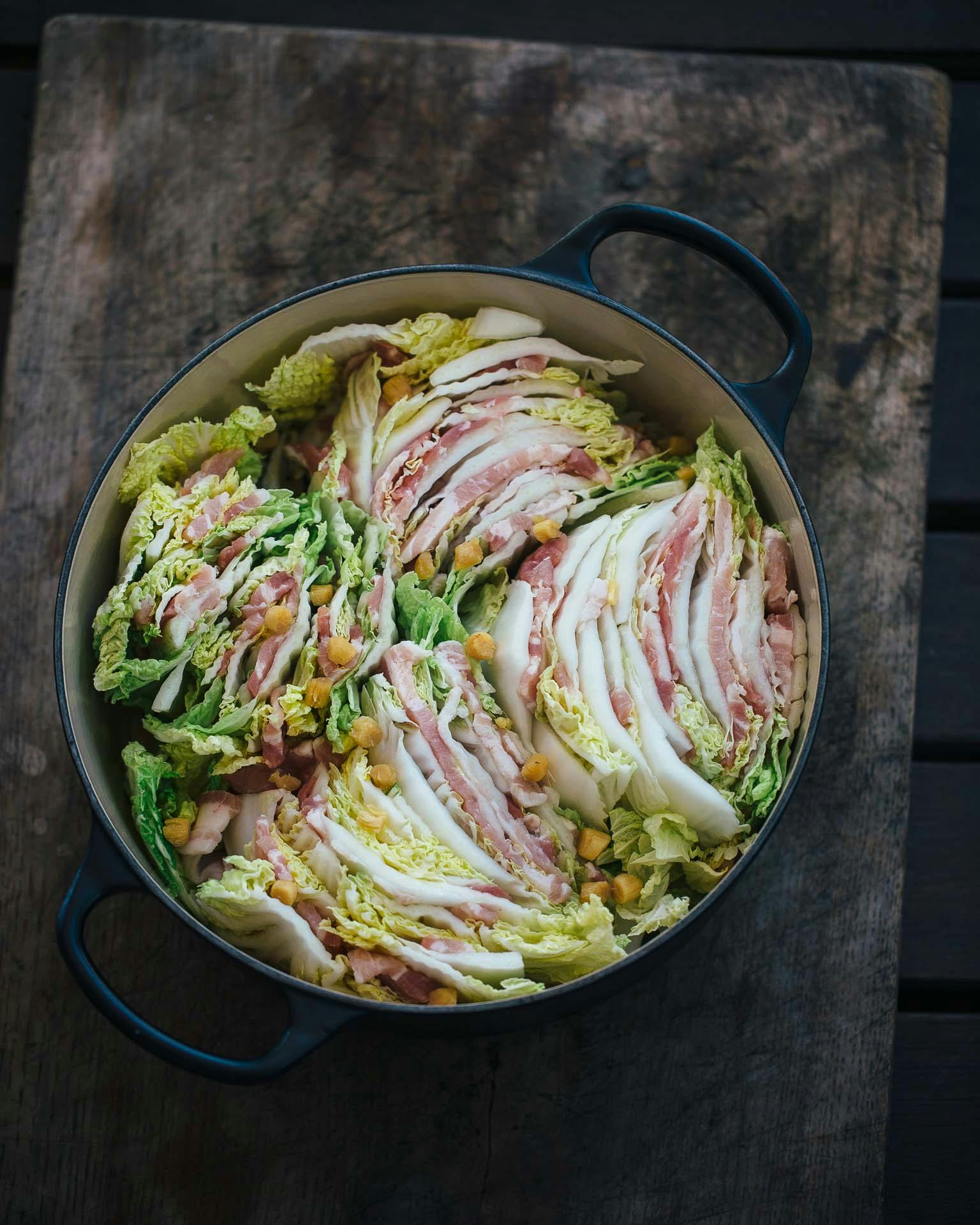Japanese Pork and Cabbage Millefeuille with Ponzu

Ingredients
600g pork belly, skin and bone removed, sliced into ½ cm wide strips
½ head of Chinese cabbage
1 tbsp sea salt
¼ tsp ground white pepper
2 tbsp sake
2 tbsp dried scallops (optional)
Ponzu
75ml sake
75ml mirin
¼ tsp caster sugar
150ml light soy sauce
75ml freshly squeezed lemon juice
1 tsp sugar (or to taste)
Method
Very thinly slice the pork belly into long strips about the thickness of bacon. You can ask your butcher to do this for you, but if you’re doing it yourself, putting the pork in the freezer for about 1 hour before you start will make it easier to cut. Separate the leaves of the Chinese cabbage. Mix together the salt and white pepper.
Lay a large leaf of Chinese cabbage on a clean cutting board and lay over 2-3 strips of pork. Sprinkle with a little of the salt and pepper mix. You don’t need to cover all of the cabbage leaf. Lay another cabbage leaf over the pork in the opposite direction (the leafy end of the top leaf should be over the stem end of the bottom leaf) and lay over 2-3 more strips of pork and scatter with a little more of the salt and pepper mix. Repeat the process, alternating the direction of the cabbage leaves, and using more leaves per layer for the smaller leaves. You should end up with a large, even and tightly packed pile of layered cabbage and pork.
Cut the block into equal thirds crossways and pack the thirds into a heavy-bottomed casserole dish; enamelled cast iron would be perfect.
Place the lid on the pot and place over low heat for 1 hour without removing the cover.
For the ponzu, boil the sake and mirin together until just boiled. Stir through the soy sauce, lemon juice and sugar until the sugar is dissolved. Allow to cool.
Serve the millefeuille with the ponzu in individual bowls as a dipping sauce.
Top Tips for Japanese Millefeuille
- A lot of people have asked if you can use bacon for this instead of pork belly. The big difference between bacon and pork belly is of course that the bacon has already been cured. If using bacon, don’t season with additional salt as it will be too salty. I would recommend using pork belly instead of bacon, as using bacon may be too heavy.
- The pronunciation of this dish is from the Japanese, not the French. In French, the dish is pronounced as for “meal-foy”, and in Japanese it is ミルフィユ, pronounced “mirufiyu”.
- Standing the cabbage and pork stack upright doesn’t just look pretty, it’s quite important to allow the steam to circulate. Otherwise the base of the dish will cook much faster than the top.
Ingredients
Method
Ingredients
600g pork belly, skin and bone removed, sliced into ½ cm wide strips
½ head of Chinese cabbage
1 tbsp sea salt
¼ tsp ground white pepper
2 tbsp sake
2 tbsp dried scallops (optional)
Ponzu
75ml sake
75ml mirin
¼ tsp caster sugar
150ml light soy sauce
75ml freshly squeezed lemon juice
1 tsp sugar (or to taste)
Method
Very thinly slice the pork belly into long strips about the thickness of bacon. You can ask your butcher to do this for you, but if you’re doing it yourself, putting the pork in the freezer for about 1 hour before you start will make it easier to cut. Separate the leaves of the Chinese cabbage. Mix together the salt and white pepper.
Lay a large leaf of Chinese cabbage on a clean cutting board and lay over 2-3 strips of pork. Sprinkle with a little of the salt and pepper mix. You don’t need to cover all of the cabbage leaf. Lay another cabbage leaf over the pork in the opposite direction (the leafy end of the top leaf should be over the stem end of the bottom leaf) and lay over 2-3 more strips of pork and scatter with a little more of the salt and pepper mix. Repeat the process, alternating the direction of the cabbage leaves, and using more leaves per layer for the smaller leaves. You should end up with a large, even and tightly packed pile of layered cabbage and pork.
Cut the block into equal thirds crossways and pack the thirds into a heavy-bottomed casserole dish; enamelled cast iron would be perfect.
Place the lid on the pot and place over low heat for 1 hour without removing the cover.
For the ponzu, boil the sake and mirin together until just boiled. Stir through the soy sauce, lemon juice and sugar until the sugar is dissolved. Allow to cool.
Serve the millefeuille with the ponzu in individual bowls as a dipping sauce.
Top Tips for Japanese Millefeuille
- A lot of people have asked if you can use bacon for this instead of pork belly. The big difference between bacon and pork belly is of course that the bacon has already been cured. If using bacon, don’t season with additional salt as it will be too salty. I would recommend using pork belly instead of bacon, as using bacon may be too heavy.
- The pronunciation of this dish is from the Japanese, not the French. In French, the dish is pronounced as for “meal-foy”, and in Japanese it is ミルフィユ, pronounced “mirufiyu”.
- Standing the cabbage and pork stack upright doesn’t just look pretty, it’s quite important to allow the steam to circulate. Otherwise the base of the dish will cook much faster than the top.

